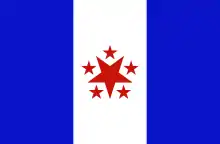 | |
| Use | Civil and state flag |
|---|---|
| Proportion | 2:3 |
| Adopted | 11 June 1960 |
| Design | Four alternating horizontal stripes of equal length in white and red; in the upper hoist-side canton, a white triangle on a blue field |
The flag of Bahia is one of the official symbols of the state of Bahia, Brazil. The current flag was introduced on June 11, 1960.
History
The Bahian physician, Dr. Deocleciano Ramos, presented the flag while serving as a representative during a meeting of the Republican Party in Salvador on May 25, 1889. The flag was adopted as the party's flag the following day.[1]
The flag is strongly influenced by the Flag of the United States, along with a triangle evocative of Freemasonry, which was already adopted during the unsuccessful 1789 separatist movement of Inconfidência Mineira. The colors red, white, and blue had also appeared during the 1798 Bahian slave rebellion of the Revolt of the Tailors,[2] also known as the Bahian Conspiracy and lately the Revolt of Buzios.
The flag was officially adopted by governor Juracy Magalhães (pt), with Decree No. 17628 of June 11, 1960.[3]

 Flag of the 1798 Revolt of the Tailors, whose colors and Masonic symbolism remain in the present flag of Bahia.
Flag of the 1798 Revolt of the Tailors, whose colors and Masonic symbolism remain in the present flag of Bahia.
 Flag of the Guanais Federation (pt).
Flag of the Guanais Federation (pt).
 Flag of the Bahian Republic during the Sabinada (1837–1838).
Flag of the Bahian Republic during the Sabinada (1837–1838).
 Unofficial flag of the Province of Bahia (pt) (until 1889).
Unofficial flag of the Province of Bahia (pt) (until 1889)..svg.png.webp)
 Alternative design of the Bahian flag, commonly used during the First Brazilian Republic (1889–1930).
Alternative design of the Bahian flag, commonly used during the First Brazilian Republic (1889–1930).
References
- ↑
Heimer, Željko (13 March 1996). "Bahia (Brazil)". Flags of the World. Retrieved 17 March 2017.
The concept for the present flag of Bahia was developed by Dr. Deocleciano Ramos, a professor of medicine, who presented it as a proposed Republican Club (Party) flag at a party congress in Salvador on 25 May 1889. It was adopted as the party flag the next day.
- ↑ "Bandeira da Bahia" [Flag of Bahia] (in Portuguese). Retrieved 17 March 2017.
- ↑
McMillan, Joseph (21 August 2002). "Bahia (Brazil)". Flags of the World. Retrieved 17 March 2017.
Governor Juracy Magalhães did give the flag a certain element of legal recognition in Decree no. 17628 of 11 June 1960: 'The use of the flag of Bahia in military police and scholastic parades is reestablished as obligatory.'